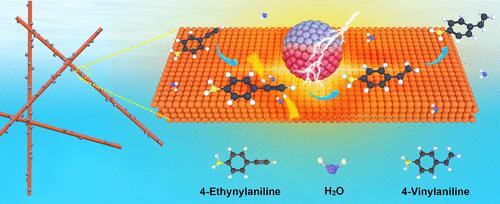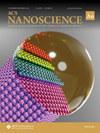通过削弱贫电子铜纳米线对烯的吸附来增强炔烃的电催化半加氢反应
IF 4.8
Q2 NANOSCIENCE & NANOTECHNOLOGY
引用次数: 0
摘要
将炔烃电化学半氢化(ESH)为烯烃是生产药物前体和聚合物单体的一项极具吸引力的技术,同时还能防止炔烃杂质对催化剂的毒害。铜被认为是一种成本效益高、选择性强的 ESH 催化剂,但其活性受到一定限制。在此,我们从机理的角度出发,假设缺电子的 Cu 可以通过促进烯解吸附的速率决定步骤来提高 ESH 活性。我们利用铜银杂化物作为电催化剂来验证这一假设,铜银杂化物是通过银纳米颗粒与铜纳米线的焊接工艺开发出来的。我们的研究结果表明,与孤立的 Ag NPs 或 Cu NWs 相比,这些合理设计的 Cu-Ag 混合物能显著提高(2-4 倍)炔烃的转化率,同时对烯产物的选择性保持在 99% 以上。通过结合操作和计算研究,我们验证了银纳米粒子和铜纳米线之间的电子转移所产生的贫电子铜位点有效地削弱了对烯烃的吸附,从而大大提高了 ESH 活性。这项工作不仅从机理上揭示了 ESH 的机理,还激发了人们采取令人信服的策略,通过杂交不同的金属来优化 ESH 的活性。本文章由计算机程序翻译,如有差异,请以英文原文为准。

Enhancing Electrocatalytic Semihydrogenation of Alkynes via Weakening Alkene Adsorption over Electron-Depleted Cu Nanowires
Electrochemical semihydrogenation (ESH) of alkynes to alkenes is an appealing technique for producing pharmaceutical precursors and polymer monomers, while also preventing catalyst poisoning by alkyne impurities. Cu is recognized as a cost-effective and highly selective catalyst for ESH, whereas its activity is somewhat limited. Here, from a mechanistic standpoint, we hypothesize that electron-deficient Cu can enhance ESH activity by promoting the rate-determining step of alkene desorption. We test this hypothesis by utilizing Cu–Ag hybrids as electrocatalysts, developed through a welding process of Ag nanoparticles with Cu nanowires. Our findings reveal that these rationally engineered Cu–Ag hybrids exhibit a notable enhancement (2–4 times greater) in alkyne conversion rates compared to isolated Ag NPs or Cu NWs, while maintaining over 99% selectivity for alkene products. Through a combination of operando and computational studies, we verify that the electron-depleted Cu sites, resulting from electron transfer between Ag nanoparticles and Cu nanowires, effectively weaken the adsorption of alkenes, thereby substantially boosting ESH activity. This work not only provides mechanistic insights into ESH but also stimulates compelling strategies involving hybridizing distinct metals to optimize ESH activity.
求助全文
通过发布文献求助,成功后即可免费获取论文全文。
去求助
来源期刊

ACS Nanoscience Au
材料科学、纳米科学-
CiteScore
4.20
自引率
0.00%
发文量
0
期刊介绍:
ACS Nanoscience Au is an open access journal that publishes original fundamental and applied research on nanoscience and nanotechnology research at the interfaces of chemistry biology medicine materials science physics and engineering.The journal publishes short letters comprehensive articles reviews and perspectives on all aspects of nanoscience and nanotechnology:synthesis assembly characterization theory modeling and simulation of nanostructures nanomaterials and nanoscale devicesdesign fabrication and applications of organic inorganic polymer hybrid and biological nanostructuresexperimental and theoretical studies of nanoscale chemical physical and biological phenomenamethods and tools for nanoscience and nanotechnologyself- and directed-assemblyzero- one- and two-dimensional materialsnanostructures and nano-engineered devices with advanced performancenanobiotechnologynanomedicine and nanotoxicologyACS Nanoscience Au also publishes original experimental and theoretical research of an applied nature that integrates knowledge in the areas of materials engineering physics bioscience and chemistry into important applications of nanomaterials.
 求助内容:
求助内容: 应助结果提醒方式:
应助结果提醒方式:


